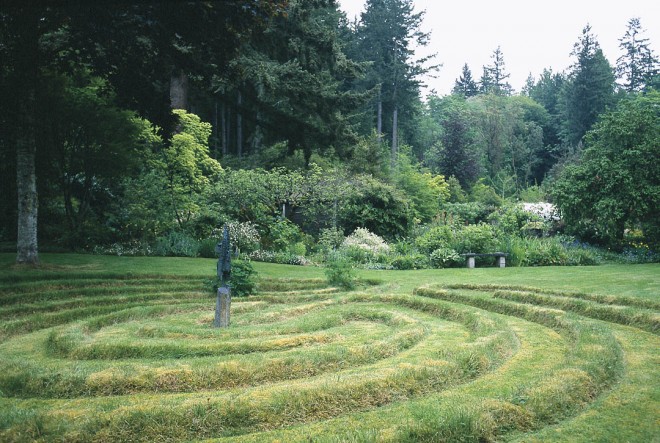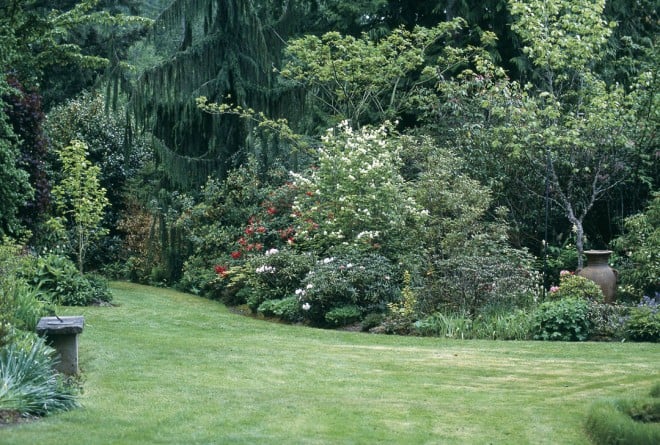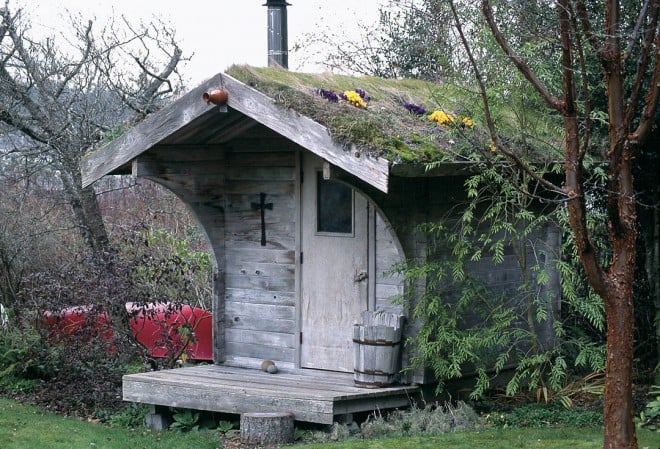
Four Seasons of Green: An Enduring Naturalistic Garden

Contributor

Anne Clark Holt inspired and encouraged the creation of a new book, The Abundant Garden. Over the course of several years, she welcomed her friend and photographer Barbara J Denk to capture the seasons of her garden on film. Similarly, Anne devoted many hours of interviews to the author, sharing her reminiscences and stories about her magical property, as well as reviewing and approving early versions of this chapter. Hers is one of nine gardens featured in the book.
Anne died on July 23, 2004, one day before her seventy-ninth birthday, as the team was finalizing The Abundant Garden for publication. Her devotion to this project inspired them to dedicate the book to Anne. The following article is excerpted from the book and remains in the present tense, reflecting the interviews from 2002 until her death.
There is a sense that you are taking a long journey to a remote, secret place when you visit Anne Holt’s waterfront garden. Towering second-growth Douglas firs and Western red cedars soar above the worn gravel driveway curving through the grass. A natural understory of native saplings, ferns, salal, and other woodland volunteers thrives at eye level, progeny of shrubs and trees that germinated following the second logging of Bainbridge Island, more than a century ago. With trees that old, the property has a quality of depth and permanence rarely seen in urban gardens. A visitor once remarked that you don’t tour Anne Holt’s garden, you “wade through its essence.”
Emerging from the long driveway into a light-filled bowl of verdant green is well worth the journey. Anne’s is a glorious, lively landscape that reminds you of the inviting strolling gardens on old English estates. Yet the diversity of foliage, color, texture, and plant forms signals that this is more than a park: it’s a plant-collector’s living laboratory.

Wide sections of lawn offer a pleasing contrast to dense hedgerows of deciduous and evergreen shrubs. Balanced among these elements are a secret walled garden and a spiral grass labyrinth, both of which evoke a sense of time standing still. Uniquely Northwest touches help define this place: rustic carved tree stumps, a cedar sauna (inspired by Anne’s fishing trips to Alaska’s Kenai Peninsula) with turf growing on its roof, and refreshing views of Puget Sound extending beyond a gravel beach.
Anne always hoped to settle on the thirty-six-square-mile island. “I used to come here as a child in the summertime,” she said. “Once I was married, my husband and I searched for a piece of land. We packed up the kids—we had two, and I was pregnant with a third child—and came over to look for property.”
That was in 1953. Anne and her husband, Irving Clark Jr, were visiting friends on Bainbridge Island when a neighbor came over with an armload of roses and mentioned she was selling her home next door. “We stepped through the fence and I knew right away that this was the place,” Anne recalls. “We wanted a western-facing piece of property, on the water. It is just a miracle that we came here—it was a great gift.”

A New Career
Used primarily as a summer residence, the partially wooded six-acre parcel was undemanding and Anne initially ignored the garden. “We didn’t do anything to the property for years; we just came over and enjoyed it,” she explains. But when Anne’s husband died in 1979, she decided to move to Bainbridge Island permanently with her youngest child, then sixteen. Anne returned to school to study horticulture and landscape design, eventually opening a small garden design business and nursery called Agate Nursery.
Growing along with her design business, Anne’s garden began to thrive as a living laboratory for all sorts of woody trees and shrubs. Active in the Seattle Rhododendron Society, Washington Park Arboretum, and the Washington Native Plant Society, Anne learned to propagate choice specimens for clients’ projects, holding onto favorite plants for her own expanding garden displays. “I wanted people who came here to see how things would look in a mature garden,” she explains.
Thus, by necessity, Anne turned her passion for plants into a career. “By the time I thought about embellishing this property, I knew every corner. I knew where the light fell and where things would grow,” she explains. This intimacy with the character of her garden informed many design choices, as Anne wove together textured borders of conifers and maples, azaleas, and woodland perennials.

A self-described “plantaholic,” Anne says she is attracted to horticultural offerings from regions with conditions similar to her own sheltered USDA zone 8 microclimate (Sunset zone 5). “Some of these plants are marginal. Some have made it. Some have not,” she acknowledges. If it can be started from seed, propagated by cuttings, or increased by division, Anne is devoted to keeping alive generations of a special plant. Unique foliage and unusual plant forms are particularly alluring. “Mother Nature does interesting things occasionally,” she says, admitting to a love for exotica in the garden. “I call them ‘witches’—plants with variations.”
Her lavishly layered garden is by no means merely a collection of oddities and quirky plants. Against a timeless backdrop of mature trees and shrubs, a few choice specimens inspire tales of their heritage. She has a dogwood tree that flourishes with five petal-like bracts rather than the typical four. Purchased for three dollars at Seattle’s Pike Place Market fifteen years ago, Anne brought it home in a coffee can. It now creates a delicate pink canopy along the north side of her garden.
The Loderi rhododendron (Rhododendron ‘Loderi King George’)—the first she ever planted here in the 1960s—was a gift from Brian Mulligan, then director of Seattle’s Washington Park Arboretum. This fragrant shrub has its pedigree in the Loderi group of rhododendron hybrids raised in the early 1900s by British hybridizer Sir Edmund Loder. Anne cherishes the perennially tasty fruit of a russet apple tree, whose parentage dates back to the Mayflower.
Anne has experimented with just about every style of garden design, from formal to naturalistic. She has raised mature specimens from seedlings and whips, turned hazardous trees into artwork, and enjoyed the freedom that comes from owning a large canvas on which to design a garden. Ornamental shrubs, trees with patterned bark and bright foliage, climbing vines with porcelain-like flowers—all are given room to grow, stretching their branches and tendrils without limits.

A Note of Formality
The most formal element of this landscape is the walled garden. In 1990, after several tours of gardens in England, Ireland, and Italy, Anne erected a rectangular walled courtyard using split-face concrete blocks, capped in brick. She credits longtime friend Penelope Hobhouse, the famous English garden maker, for inspiring the design. “I always wanted to come home from England with a castle or wall fragment,” Anne jokes. “When Penny visited, we had her stand on a chair to help plan our own walled garden.”
Hobhouse recommended using the lap pool’s proportions to guide the enclosure’s scale, placing it perpendicular to the fifty-foot long swimming pool and patio. Ed Kopp, a carpenter from Seattle, fabricated the massive hinged gates using Alaskan yellow cedar planks. The gates provide access through the north and south walls of the garden. Once inside, you are transported to the British Isles.
With benches, urns, and pathways of rosy crushed marble and sand, the walled garden creates its own microclimate. Eucryphia cordifolia, with creamy white summer blooms and glossy green foliage, grows in each corner. Camellia sasanqua branches are trained along the sheltering walls, providing a rosy contrast against the stone. Climbing hydrangea, roses, and trumpet vines lend a blanket of color and foliage. Peonies, roses, clematis—English garden traditions—indeed belong here, as does the trim boxwood edging. This is a timeless sanctuary.
Along the southern border of her land, Anne once removed a row of fir and cedar trees that were threatening to destroy the lattice fence, paying her sons and their friends to chop the trees into firewood. She then planted the horizontally spreading rockspray cotoneaster (Cotoneaster horizontalis) to splay its distinctive herringbone-patterned branching against the new fence. “When the leaves drop off, the berries hang on. It’s wonderfully colorful,” she enthuses. Against this backdrop grow Japanese maples (Acer palmatum) and rhododendrons, statuesque and shading much of that side of the garden. “The trees have made this garden turn from sunny to shady,” she admits. A border of hostas and other perennials, with dwarf Japanese maples, Franklinia alatamaha, and groundcovers flanks a path that meanders through the trees.

From Bog to Pond
Beyond the walled garden is Anne’s pond, sited appropriately at a boggy spot that collects water runoff from the wooded area above. Thriving around its perimeter are sedges (Carex), gunnera, irises, and willows (Salix), lavishly growing together and obscuring the water’s edge. “I didn’t plant much, because I wanted to see what would come up naturally,” she explains.
Having begun life as a whip cut from a felled tree elsewhere on the property, a stately willow dips its branch tips into the pond’s surface. “It’s a perfectly gorgeous feature that began when I just stuck it in the ground,” Anne says. The otherworldly, water-loving gunnera plants thrive here, happily spreading their prehistoric leaves to shade tiny primulas that grow at their feet.
When a weeping sequoia (Sequoiadendron giganteum ‘Pendulum’) succumbed to age and toppled into the pond, Anne allowed it to remain where it fell. “That sequoia was always leaning toward the sun, and it reached too far,” she explains with a knowing grin. Otters, turtles, and other wildlife frequently visit this natural bridge, welcomed by the pair of sculpted cranes that reside alongside it.
Anne says the best feature of her garden is the “part I haven’t touched.” With more than half of her property left undeveloped as nature’s handiwork, she has given a conservation easement to the Bainbridge Island Land Trust. “It means I cannot do anything, cut any trees, or remove anything from the area above the pond up to the road.” The easement ensures that this natural area will remain untouched for future generations to enjoy, even as the garden evolves and matures.

Postscript
An ardent plantswoman and designer, Anne Holt created an alluring garden legacy. The landscape was her venue for artistic expression. She continued to share this treasured place with friends and loyal horticultural visitors. Well into her retirement years, Anne continued consulting on landscape design, spending much of her last year creating a meditative garden for her new parish sanctuary. “Gardening is even more important to me,” Anne said of her last years; “I’m concentrating on growing plants in pots that I can move around the house.” You can be sure that those containers were an abundant, moveable feast for the eyes.
Excerpted and adapted with permission from The Abundant Garden, an inspiring new book by Debra Prinzing with photographs by Barbara J Denk, published in 2005 by Cool Springs Press.
The Timeless Approach
To grow an abundant garden with a sense of timelessness in less than a lifetime, the goal is to unify and knit together areas of the garden, softening the edges and removing the sense of newness. Here are some guidelines, drawn from the experiences of Anne Holt and other gardenmakers in The Abundant Garden:
Organic Architecture: Hardscape materials that suggest a sense of age and rich character successfully communicate timelessness in the garden. The seasoned look of weathered rock, mossy wood, vine-draped trellises, and aged metal objects—all effective choices—can suggest that they were placed years before. Avoid shiny or glossy in favor of galvanized or matte-finished surfaces; add interesting twigs and branches to adorn an ordinary arbor or gate; encourage ground covers to cushion the spaces between stepping stones or pavers.
Plants and Placement: We can select and place plants that fill a garden with timeless character. Group several young trees in an inviting stand of three or five, instantly giving a presence that a single tree could not offer. Grow informal layers of horizontal plants beneath vertical ones; the eye will see a pleasingly textured composition. Frame borrowed views of adjacent gardens, parks, greenbelts, or pastures, either by placing columnar trees or shrubs at an entrance or by training vines over an archway. Direct pools of light into secret grottos.
Groundwork: Bare soil is an instant giveaway that a garden is young. Strike a balance between anticipating the ultimate size a shrub or tree may command in your garden and planting everything so close together that your garden seems crowded. Be aware that, later, you may have to edit, thinning beds and borders as plants get larger. With perennials, you can integrate plants more densely, using a combination of tall, medium, and smaller choices. Add interest by moving dynamic vertical plants to the foreground, especially those with an open-form that do not obscure what’s behind them. And, wherever possible, plant ground covers that can do double-duty in the garden, suppressing weeds and masking bare soil. Woolly or creeping thymes (Thymus pseudolanuginosus; T. praecox subsp. arcticus), baby’s tears (Soleirolia soleirolii), blue star creeper (Pratia pedunculata), creeping Jenny (Lysimachia nummularia), and stonecrop (Sedum spp.) are among the many ground cover choices that will take root and seem timeless once established.
Adornments: Choose garden art and ornamentation with an enduring quality. Aged urns and planters give permanence in the landscape. Select objects carefully, letting the few you display harmonize rather than compete with the plants. Allow artworks to be partially obscured by branches, or encourage vines like clematis to grow nearby so that their tendrils will entwine the sculpture or artifact.
Debra Prinzing
Share:
Social Media
Garden Futurist Podcast
Most Popular
Videos
Topics
Related Posts

Ground Up Science for Greener Cities with Garden Futurist Dr. Alessandro Ossola
Spring 2023 Listen to the Podcast here. Alessandro Ossola is a scientist who gets very excited about the challenge of climate change allowing for an

Readying Urban Forests for Climate Realities with Garden Futurist Dr. Greg McPherson
Winter 2023 Listen to the Podcast here. “Going from the mow and blow to a more horticulturally knowledgeable approach to maintaining the landscape. And that

Low Maintenance Gardens – Better for Pollinators and People
Autumn 2022 “I come out every day. It’s therapy, my meditation.” Janet’s young garden transformed from overgrown, invasive plants to mostly natives. The dailiness of

Invasive Plants Are Still Being Sold: Preventing Noxious Weeds in Your Landscape
Autumn 2022 With so many beautiful ornamental plant species and cultivars throughout California and the Pacific Northwest, how do you decide which ones to include











Responses